I’ve loved visiting the Netherlands throughout my life, and despite being unique in many ways I can’t help to notice how similar it is to the Scandinavian countries Denmark, Sweden, and Norway (+ Finland and Iceland in some cases). It might be the uniquely mutual love of herring, the same freakishly tall average height, or the many shared words and phrases I’ve overheard when hanging out with primarily Dutch-speaking groups of people, both in the Netherlands and abroad. Either way, there’s arguably some form of connection!
Since the links seem so strong despite no formal connection, I wanted to find out more about how Netherlands and Scandinavia actually are connected. Let’s start off with getting our bearings and looking at where the two are located, then we’ll dive into the many similarities.
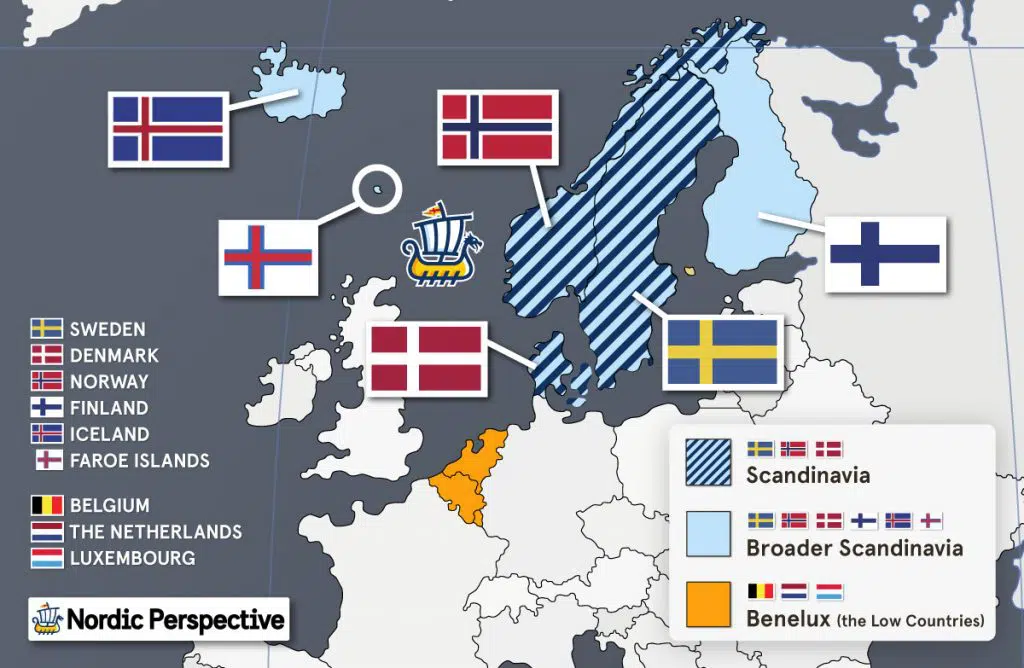
So How are Dutch People Similar to Scandinavians?
The Dutch and Scandinavians share many characteristics and traits in the modern age; average length, diet, pop culture, secularism, English proficiency, and a strong love of bikes. They also share a Germanic ancestry, originating from the Nordic Bronze Age culture (from southern Scandinavia).
While modern-day Dutch and Scandinavians can be a diverse bunch due to multiple immigration waves from the rest of Europe, Africa, and the Middle East during the last millennia, we can still see clear ancestral links between the two regions in their modern-day populations, using modern genealogical analysis and data.
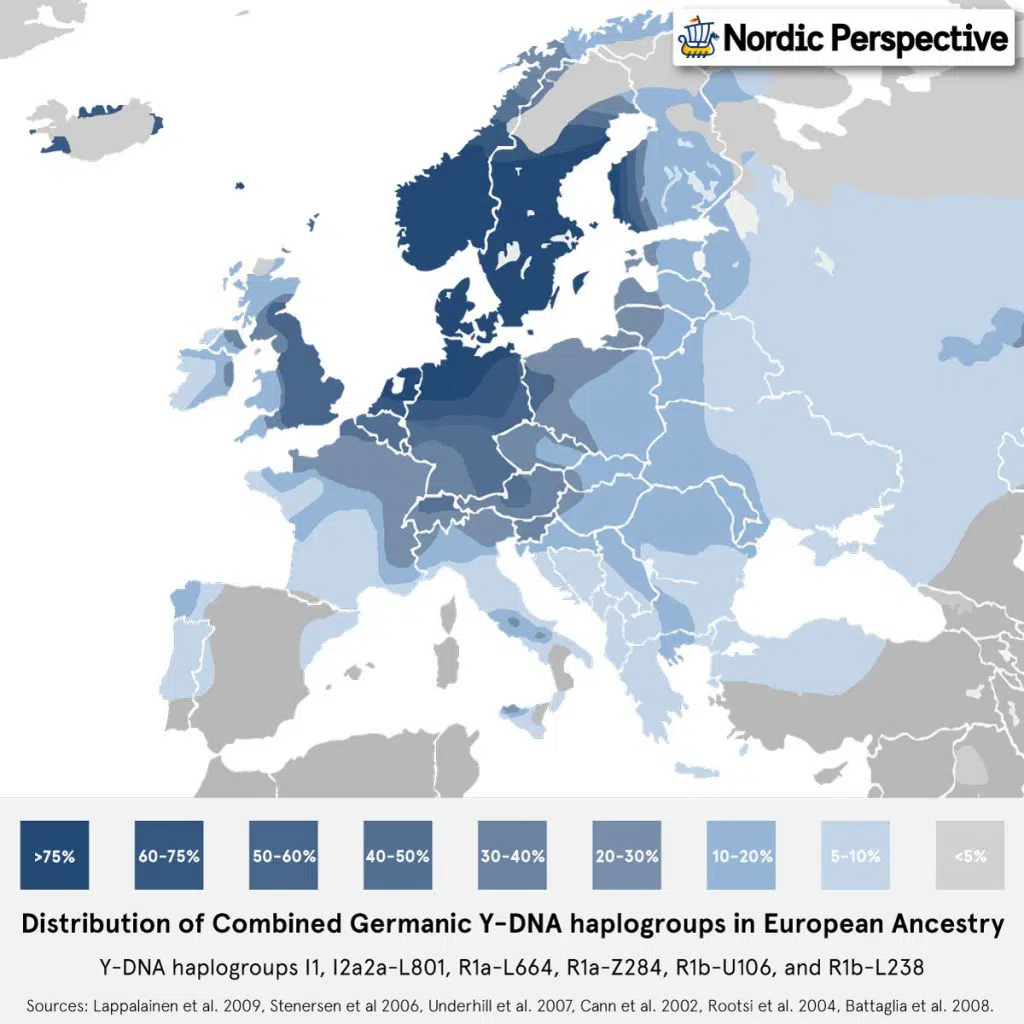
We can also see this genetic link between the Dutch and Scandinavians when we look at another DNA study mapping out where in Europe modern-day Scandinavian and Dutch ancestors originated from. Here we see both regions have a large proportion of Nordic ancestors, and a similar amount of Eastern and Central European ancestors.
They do however differ in one area, as the Netherlands has around 4 times more southern European ancestry than the Scandinavians do, who in turn have around 50% more Nordic ancestors (not surprising as they are Nordic).
Netherlands Ancestral Component
S Jutland (Denmark) Ancestral Component
Source: G Athanasiadis et. al. 2016
Let’s continue by looking at where the people who founded and live in the Netherlands, Denmark, Sweden, and Norway originally came from, to get a clearer sense of how they are related.
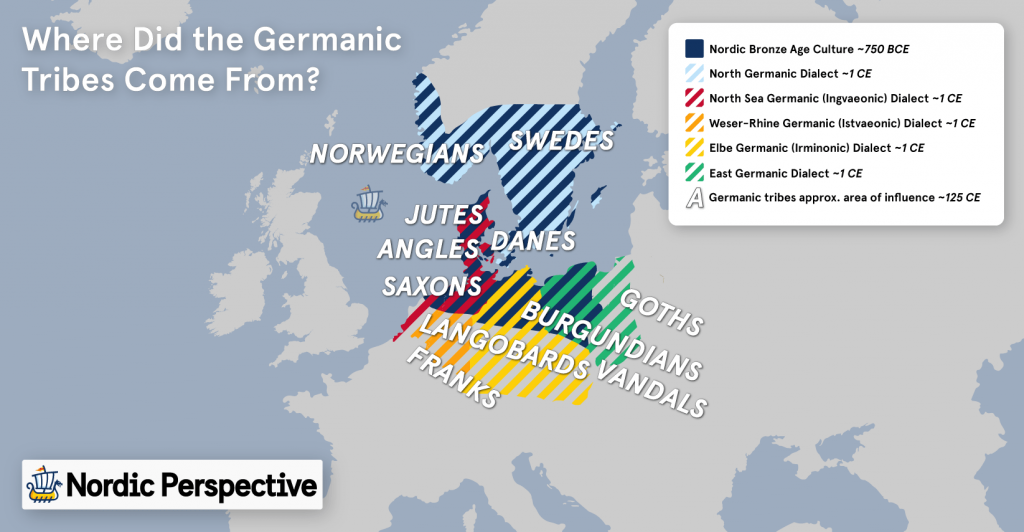
The Dutch and Scandinavians Have Common Germanic Ancestors
The Dutch are believed to mostly hail from three Germanic tribes (the Frisians, Low Saxons, and Franks) while the Scandinavians mostly hail from another group of Germanic tribes (Norwegians, Swedes, Geats, Danes, Jutes, and Angles). As mentioned, all of the Germanic tribes are believed to hail from a common ancestral bronze age culture based in southern Scandinavia (the Nordic Bronze Age culture).
The demographics of each region are ultimately much more complicated than that, but this common ancestry has likely contributed to the common traits and similar cultures we can see today.
Common Traits Between the Dutch and Scandinavians
- 🦒 Among the tallest people in the world
- 👱🏼♀️ Majority of population has light hair
- 👩🏼🦰 Similar proportion of population has red hair
- 🧿 Majority of population has light eyes
The populations of Netherlands and Scandinavia share many genetic traits, especially those that are unique for Northern Europe (i.e. light hair and eye colors). There is also a stark similarity in average height, where the Netherlands and the Nordic countries repeatedly place towards the top globally speaking.
Here’s a closer look at the data behind these conclusions:
| Country | Female avg. height | Male avg. height | Global rank |
|---|---|---|---|
| Netherlands | 170 cm / 5 ft 7 in | 184 cm / 6 ft 0½ in | 1st |
| Montenegro | 170 cm / 5 ft 7 in | 183 cm / 6 ft 0 in | 2nd |
| Estonia | 168 cm / 5 ft 6⅛ in | 182 cm / 5 ft 11½ in | 3rd |
| Denmark | 169 cm / 5 ft 6 in | 182 cm / 5 ft 11½ in | 4th |
| Bosnia | 167 cm / 5 ft 5¾ in | 182 cm / 5 ft 11½ in | 5th |
| Iceland | 168 cm / 5 ft 6⅛ in | 181 cm / 5 ft 11¼ in | 6th |
| Sweden | 167 cm / 5 ft 5¾ in | 180 cm / 5 ft 10⅞ in | 12th |
| Norway | 166 cm / 5 ft 5⅜ in | 180 cm / 5 ft 10⅞ in | 13th |
| Finland | 166 cm / 5 ft 5⅜ in | 180 cm / 5 ft 10⅞in | 17th |
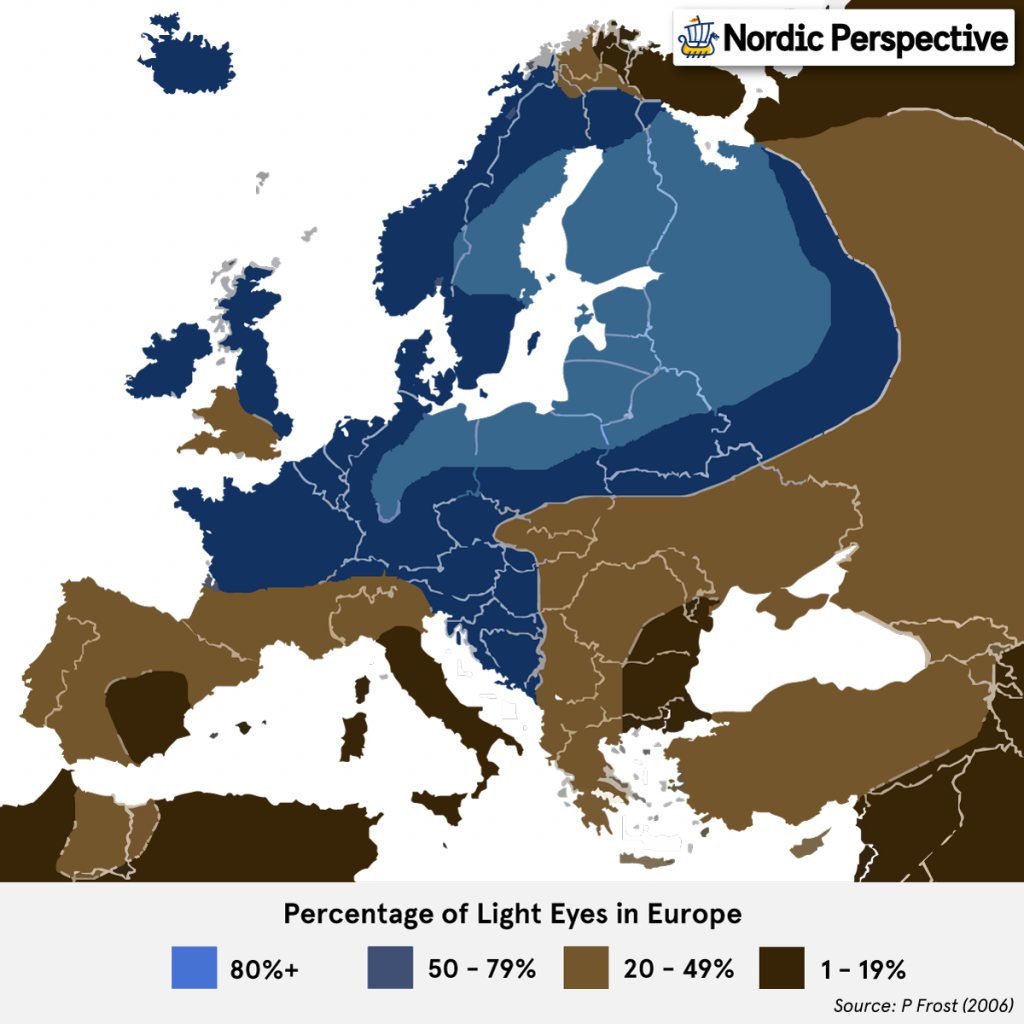
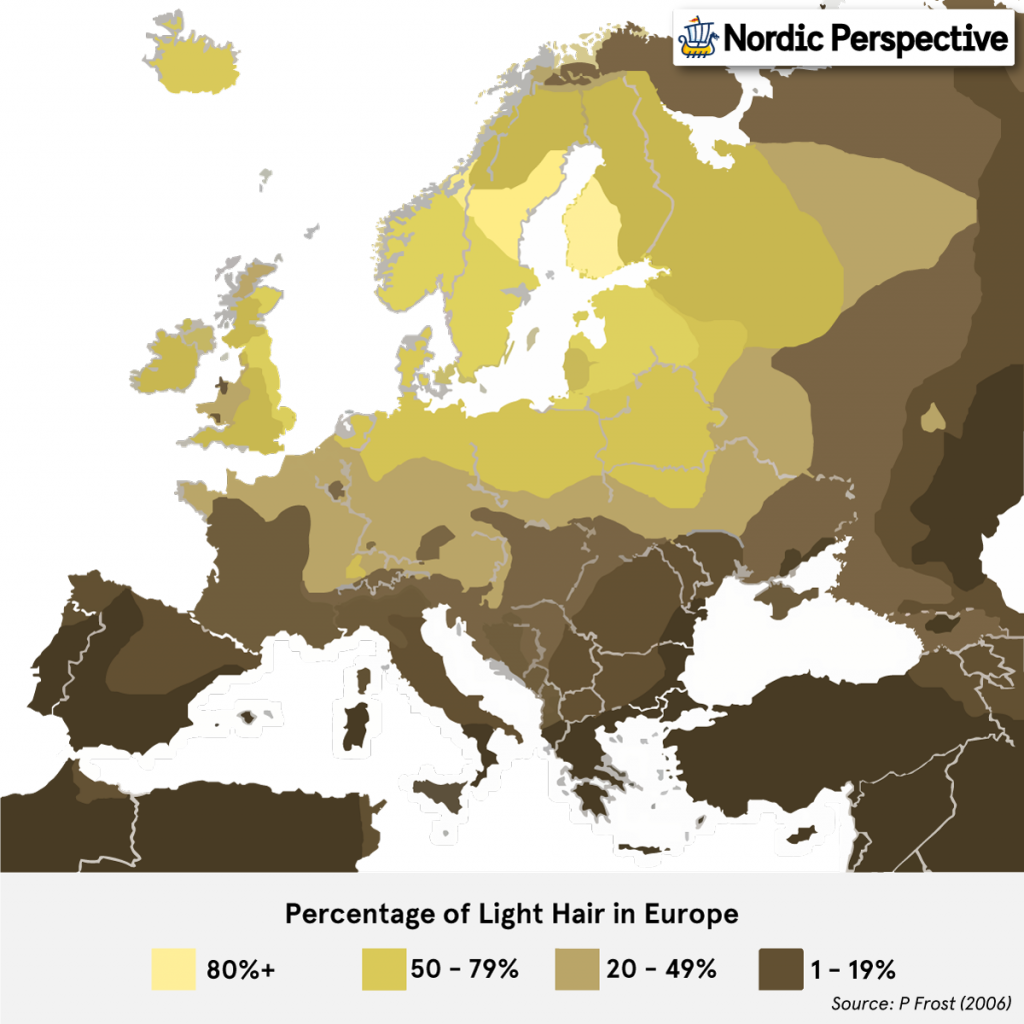
What Values Do Scandinavia & the Netherlands Share?
- ⚖️ Equality & egalitarianism
- 🗳️ Democracy
- 🗽 Liberty & Human Rights
- 🤥 Honesty
- 🔒 Privacy
- 😌 Informality
- ⏰ Punctuality
- 🔮 Forward-thinking
Scandinavia and the Netherlands are in a similar location along the North Sea coast in Europe, and like most countries in the area share many cultural and political values and characteristics.
In the modern age the two regions each have their unique values and norms, but ultimately share most of those associated with western democracies in general.
How is Scandinavian & Dutch Culture Similar?
- 🎬 Similar media consumption and pop culture
- 🆗 Both countries understand and speak English well
- 🐟 We eat similar food (for the most part)
- 💻 Both countries have a very high amount of PCs per thousand people
- 📱 Both have a high amount of mobile phones per 100 people (127.57 vs 134.8 in 2019)
- 🌐 Both have a high amount of broadband subscriptions per 100 people
- 🔌 Both consume a high amount of electricity per capita
- 👩🎓 Both have well-educated populations (11.4 vs 12 years of schooling on average)
- 📿 Both countries are culturally diverse
- 👑 Constitutional monarchies
The similarity in cultures in Scandinavia and the Netherlands can be traced back to a common ancestral culture dating back to the bronze age, followed by a closely intertwined history (like most of Europe).
Scandinavians visiting the Netherlands have an easy time adapting and recognize many aspects of daily life, and its a known fact that the Dutch practically invade Scandinavia in the summer time in search of open spaces and unpredictable summer days.
It’s easy to see similarities between the two regions in person too, as a visit to the Netherlands is going to share a lot of similarities with a trip to Scandinavia; temperate climate, coastal cities with renaissance style buildings and canals, herring and tall people everywhere, and a very good understanding of English.
So while the Dutch and Scandinavians may not reflect on it that much, the two regions share a strong connection and many modern day cultural and political values that are more apparent to outsiders.
Are the Dutch Related to the Vikings?
The Dutch people are believed to originate from the same Nordic Bronze Age culture as the Norse (a.k.a. Vikings), a common ancestry that ultimately connects all Germanic cultures and languages. Furthermore, parts of the Netherlands have been tied politically and culturally to Scandinavia since before the Viking Age.
Frisians especially share a political, cultural, and linguistic past with Scandinavia that goes back long before the Vikings started raiding the North Sea coast in 810 CE.
Later on, the Franks also attempted to stop the Viking raids by giving the province of Frisia as a fiefdom to the Viking King Sigfrid in 882 CE, further weaving the two even closer together.
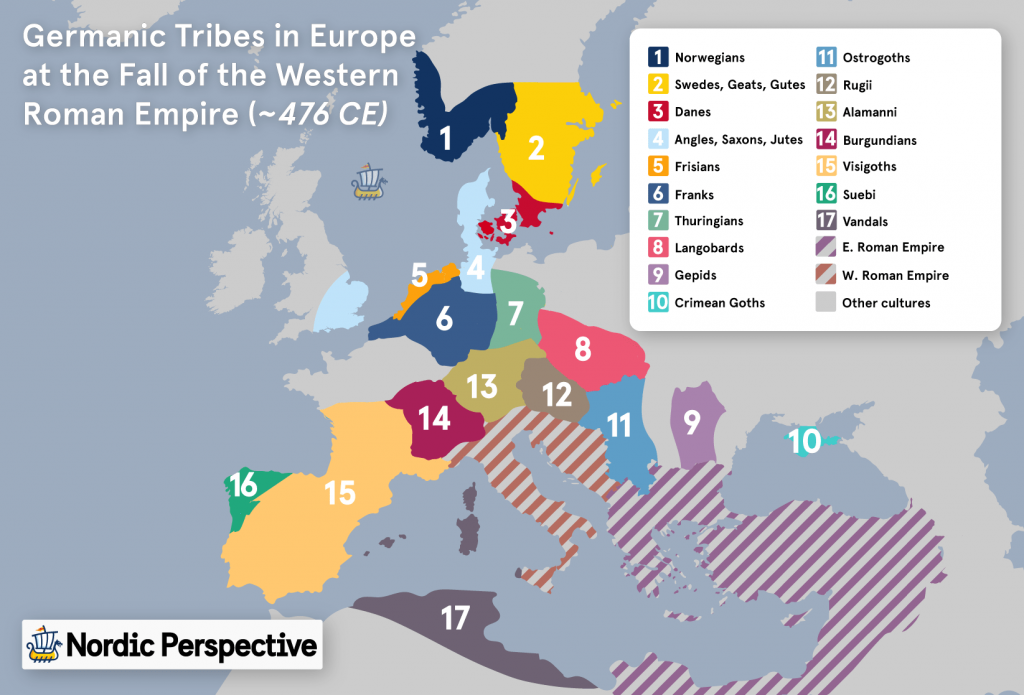
Did Vikings Speak Dutch?
Vikings spoke what we today call Old Norse, which originated from the modern Scandinavian languages Swedish, Danish, and Norwegian. They are however all Germanic languages, just like Dutch, meaning the people living in Viking Age Netherlands could have some sort of basic understanding of the Norse languages.
Is the Netherlands Scandinavian?
The Netherlands is not part of Scandinavia, despite sharing the same Germanic roots as the Scandinavian people and many similar modern-day ancestral and cultural traits. Netherlands is however part of the Benelux region (sometimes called the Low Countries), which also includes Belgium and Luxembourg.

Benelux (the Low Countries) vs. Scandinavia
| Benelux (the Low Countries) | Scandinavia | |
|---|---|---|
| Countries | Belgium, the Netherlands, Luxembourg (🇧🇪🇳🇱🇱🇺) | Denmark, Norway, Sweden (🇩🇰🇳🇴🇸🇪) |
| Languages | Dutch, French, German, Luxembourgish, West Frisian | Danish, Norwegian, Swedish, Sami |
| Language families | Germanic (4), Romance (1) | Germanic (3), Uralic (1) |
| Population | 29 554 771 | 21 495 140 |
| Total Area | 75 149 km2 (29 015 sq mi) | 817 191 km2 (315 519 sq mi) |
| GDP | USD $1.580 trillion | USD $1.136 trillion |
| GDP per Capita | USD $48 359 | USD $52 863 |
| Currencies | Euro | Danish Krone, Norwegian Krone, Swedish Krona |
| Continent | Europe | Europe |
| Sub-region | Western Europe | Northern Europe |
The Benelux region and Scandinavia do share some common characteristics on top of the geographical proximity, both including 20-something million people, speaking mainly Germanic languages, and having a GDP per capita around $50 000 USD. No wonder people mix them up a bit from time to time!
Are the Dutch Considered German or Scandinavian?
The Dutch are not considered German or Scandinavian in culture or ethnicity, but they do have German as well as Scandinavian ancestry through the three Germanic tribes that originally settled the Low countries: the Franks, Low Saxons, and Frisians. Around 2.4% of the Dutch population also directly identify as German.
Are Dutch and the Scandinavian Languages Mutually Intelligible?
The Dutch and Scandinavian languages are both within the Germanic language group but are not mutually intelligible. They do however share plenty of words and grammar, and ultimately both stem from a Proto-Germanic language that developed in southern Scandinavia during the Bronze Age.
The Scandinavian languages are North Germanic, while Dutch is considered West Germanic, which goes back to the split and expansion out of Scandinavia for what would later become the Germanic tribes.
West Germanic Tribes such as the Frisians, Franks, and Saxons expanded westward along the North Sea coast, and North Germanic Tribes such as the Danes, Swedes, Geats, Norwegians stayed in Scandinavia (well, sort of… after all Vikings have Germanic roots too).
Quick Answers:
Is Denmark Related to the Netherlands?
Denmark and the Netherlands do not have any formal relations and are not part of the same geo-political region, but they do share a common history and ancestry through the Germanic tribes that originated from southern Scandinavia during the Bronze Age.
Both areas followed the Norse gods up until the Christianization of Europe, and Frisia upheld political, cultural, and commercial ties with the Scandinavian countries long before the Viking Age began.
Can Dutch People Understand Danish?
Dutch people can generally not understand Danish, nor can Danes understand Dutch especially well. That said, the two languages are part of the Germanic Language Group so they do share some words, sounds, and grammar that make it fairly easy to learn the other’s language.
Is Sweden Part of the Netherlands?
Sweden is not part of the Netherlands as it is its own country located in Scandinavia. The two countries do share a common history and ancestry through the Germanic tribes that originated from southern Scandinavia during the Bronze Age.
Both places worshipped the Norse gods up until the Christianization of Europe, and Frisia and Scandinavia were tied together politically, culturally, and commercially before the Viking Age began.
Can Swedish Speakers Understand Dutch?
Dutch people can generally not understand Swedish, and Swedes don’t understand Dutch either. The two languages are, however, both part of the Germanic Language Group so they do share words, sounds, and grammar that make the languages fairly easy to learn for both.
Sources:
https://www.jstor.org/stable/45020171
http://www.cell.com/AJHG/abstract/S0002-9297%2807%2962002-3
https://academic.oup.com/genetics/article/204/2/711/6046829
https://spraktidningen.se/2015/06/tva-sprak-tva-forsvar/
https://www.olandsbladet.se/kulturnoje/motet-mellan-svenskar-och-hollandare-kulturkrockar/
https://www.sprakbruk.fi/-/svensk-nederlandsk-sprakkontakt
https://si.se/app/uploads/2021/04/arsrapport-2020.pdf
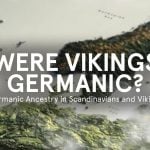 Scandinavian, Viking & Germanic Links Explained (With Maps)
Scandinavian, Viking & Germanic Links Explained (With Maps)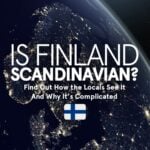 Is Finland Scandinavian? (The Full Answer)
Is Finland Scandinavian? (The Full Answer) Nordic vs. Germanic vs. Celtic: Differences & Links Explained (+ Maps)
Nordic vs. Germanic vs. Celtic: Differences & Links Explained (+ Maps)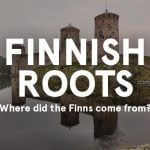 Finnish Heritage: Nordic, Viking, and Baltic Ties Explained
Finnish Heritage: Nordic, Viking, and Baltic Ties Explained

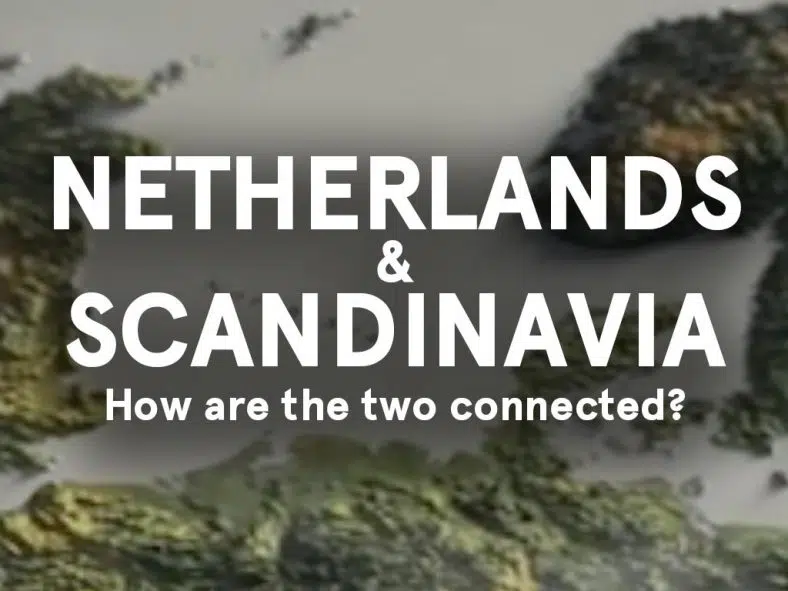
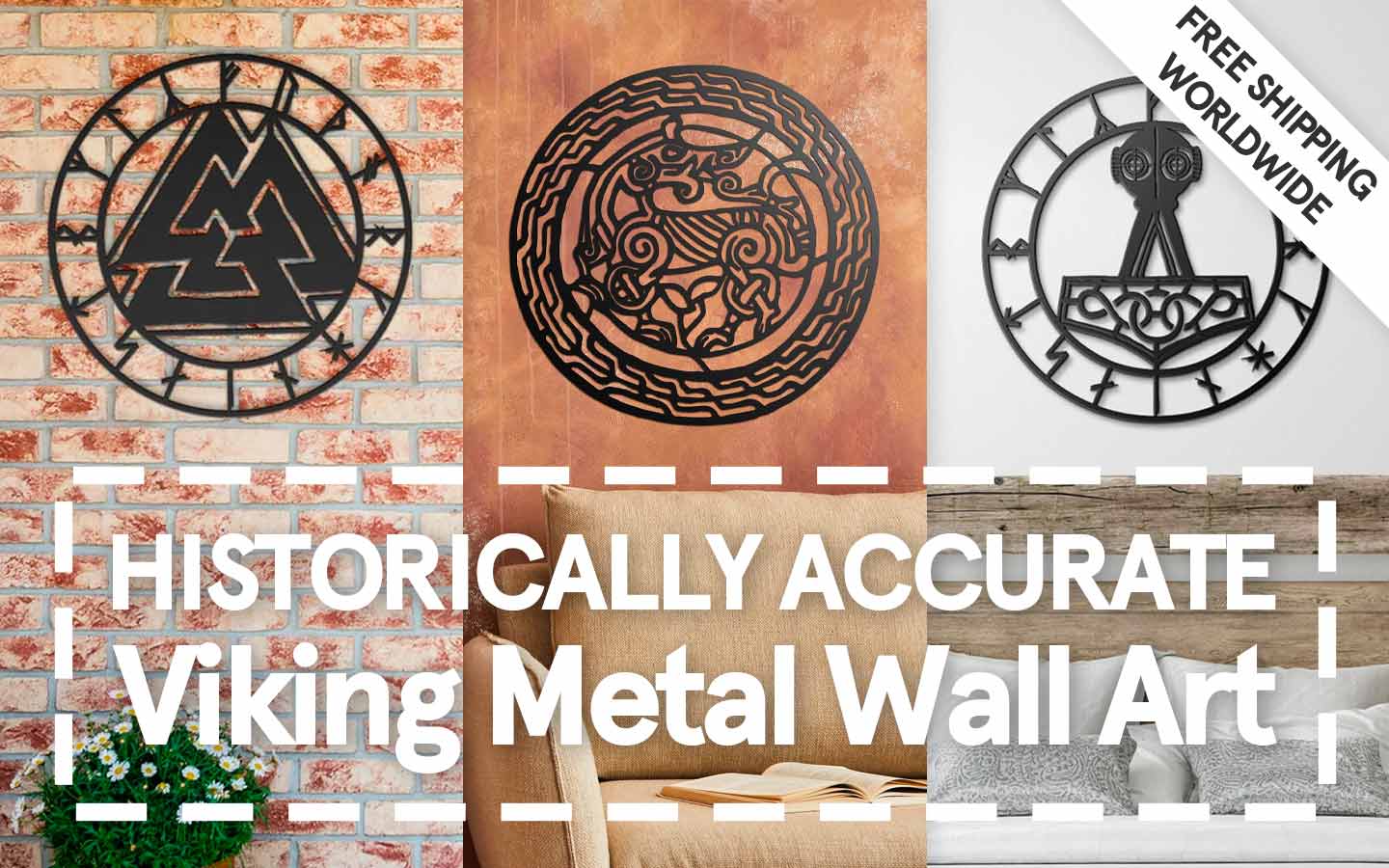
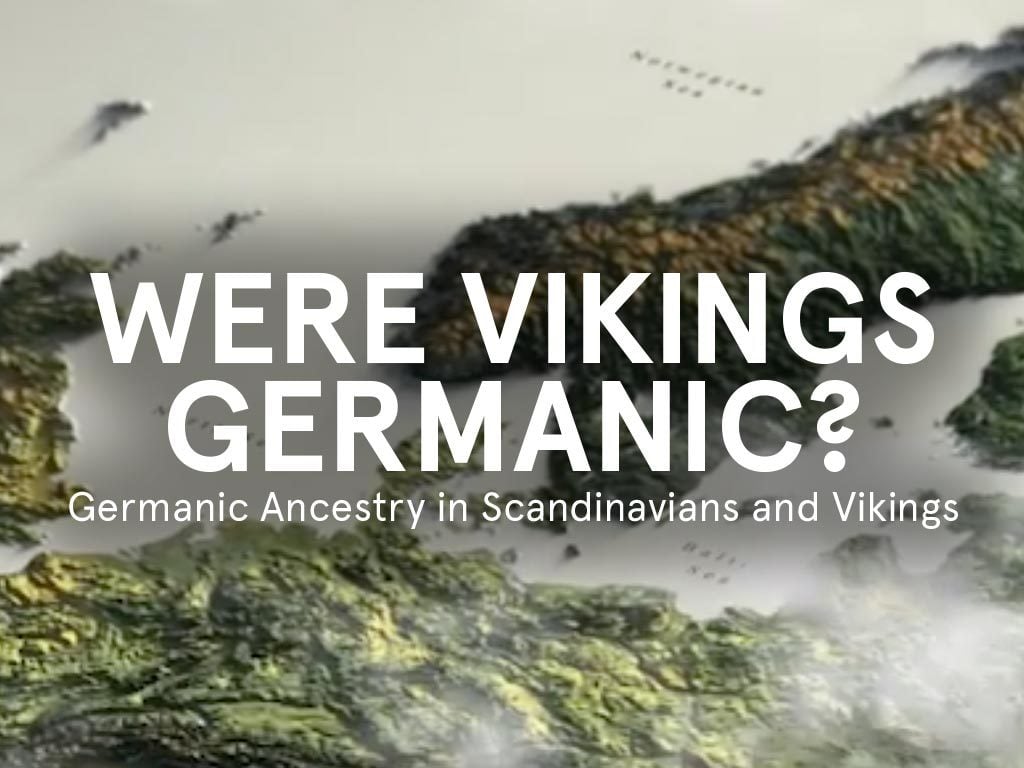
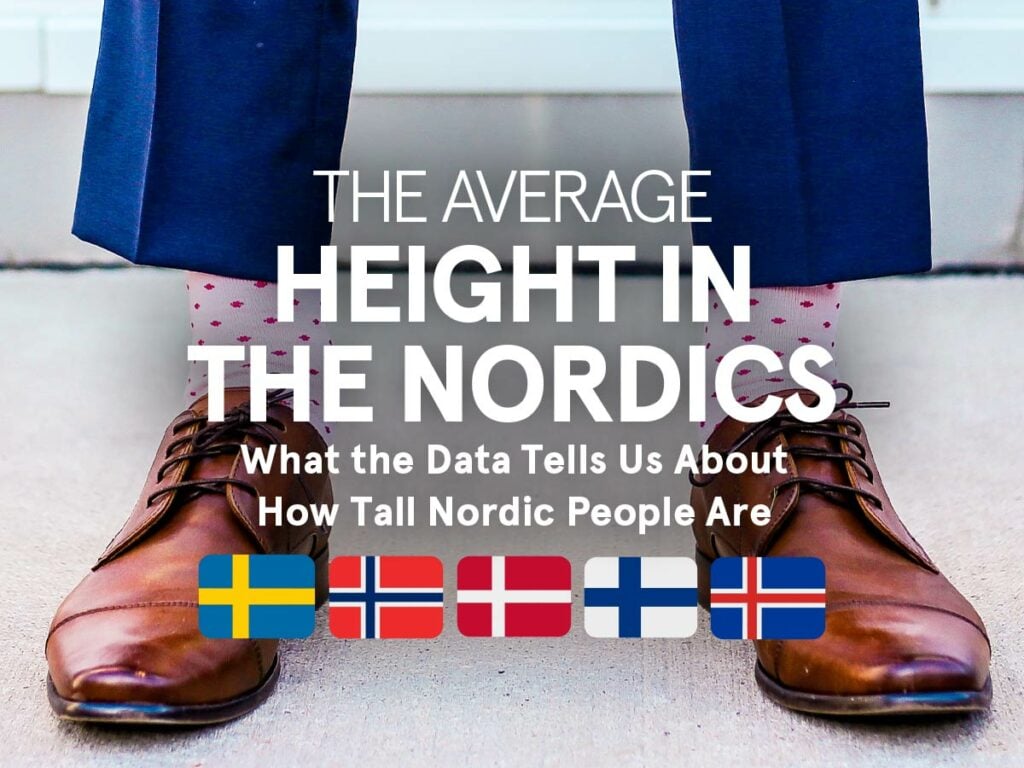
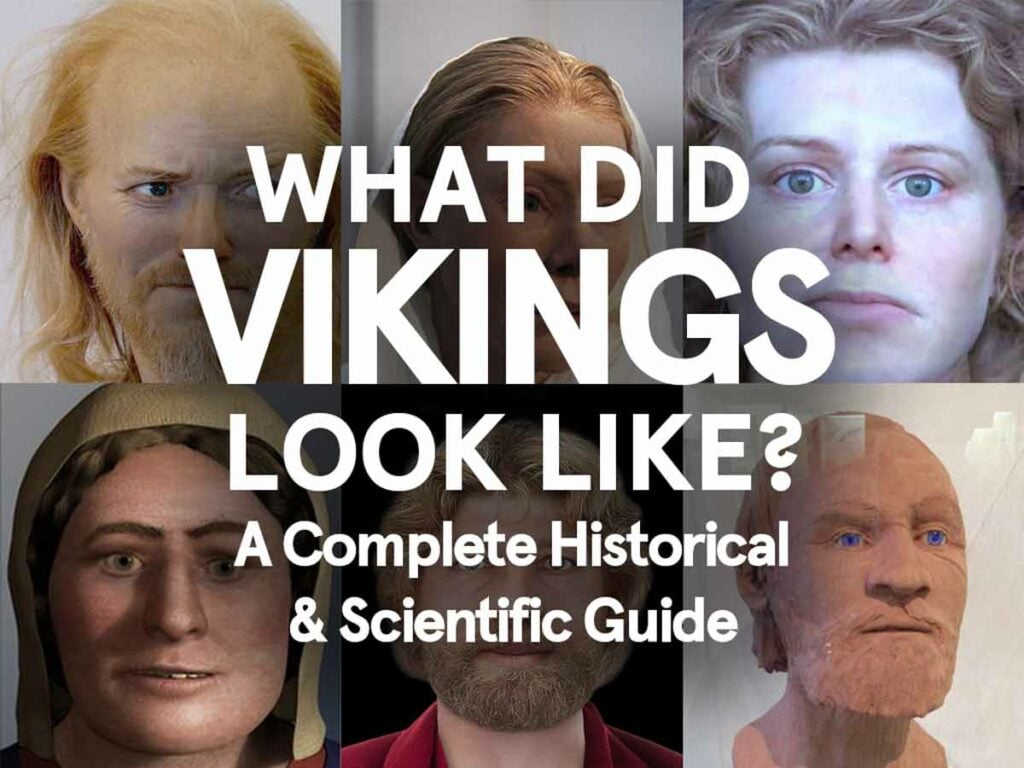
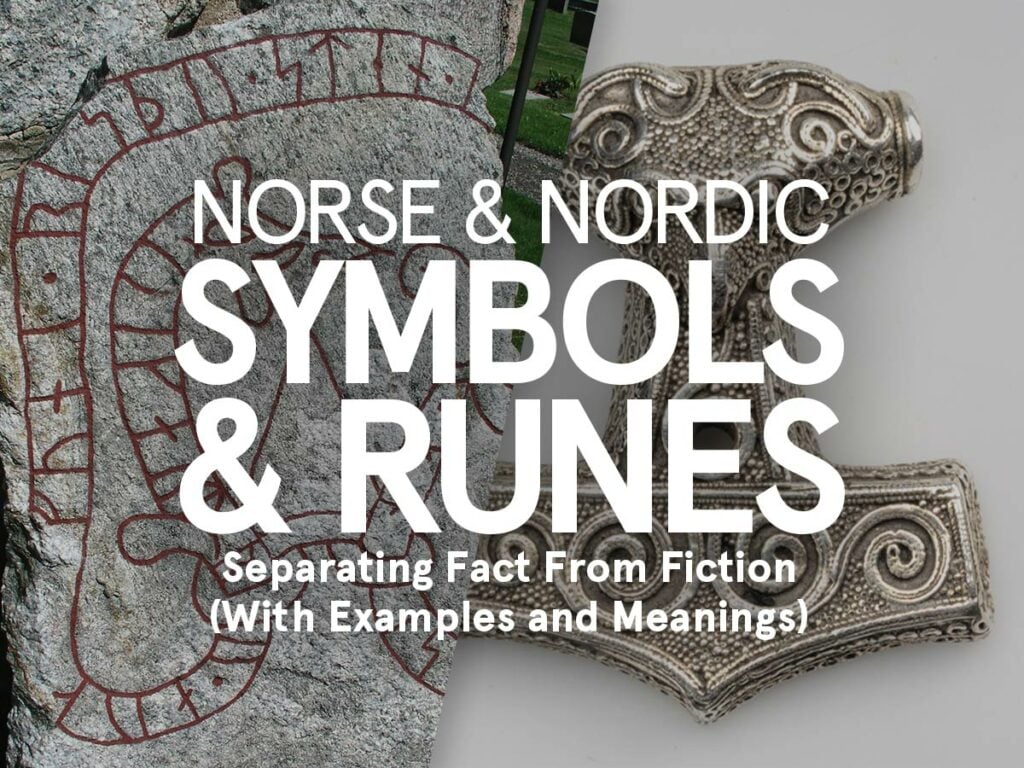
Just a question: do you consider the Finns to be Scandinavian?
Hi Emily!
Linguistically speaking Finns are a Finno-Ugric people, while Scandinavians are a North Germanic people. And since language generally is the preferred way to categorize cultures and ethnicities in the scientific community, I personally don’t consider my Finnish relatives (or Finns in general) to be Scandinavian, but I certainly consider them and Scandinavians to both be very Nordic.
It is a bit more complicated than this in reality though (especially in the English-speaking world, where they generally pretty much equate Nordic and Scandinavian as one and the same, minus Greenland and Jan Mayen Islands), and I dive a bit deeper into whether or not Finns are Scandinavian in a separate article. Check it out if you’re interested!
May be but in NL we put Finns together because we see the Scandinavian peninsula starting from Finland and so to the west. We mostly hear abotu Scandinavia during winter on the weather so we have a famous Scandinavian high pressure area that gets us (got us) real winterweather (so we can skate!). It is always about that high pressure are and here FInland is sure included. But for us it is the Scandinavian peninsula and Finland, in our view is on it. Denmark is not, but they talk funny too so they are included as well.
Here’s an odd one I’m having a hard time wrapping my head around I am 1/4 dutch thanks to my dad’s side where he is half dutch. I found it odd when he did a DNA test it gave no genetic ties to western Europe despite the fact that I know my Oma is dutch. It did however give him a large amount of Scandinavian heritage and I am unsure as to why.
Hi Karl,
I have looked quite a lot into the origin of the Frisians. And nowaydays there is evidence that Frisians are actually Anglo-Saxons (and I think mainly Angles).
If you compare their DNA, they resemble West-Norwegian but are even closer to Longobards.
A few of the sources:
Nicolay, J., Nieuwe bewoners van het terpengebied en hun rol bij de opkomst van Fries koningschap. De betekenis van gouden bracteaten en bracteaatachtige hangers uit Friesland (vijfde-zevende eeuw na Chr.) (2005)
Anglo-Saxon immigration or continuity? Ezinge and the coastal area of the northern Netherlands in the Migration Period.
Hi Arjan!
That would make sense as the Anglo-Saxons likely migrated to England through Frisia – and either way they seem to all have originated from southern Scandinavia and the Nordic Bronze Age Culture. The Lombards/Langobards similarly originated from Scania in Southern Sweden, which would also make sense from a geographical perspective as that is fairly close to where the Angles and Saxons established their culture (i.e. Western Denmark and Northern Germany).
If you’d like to dive deeper, you can read more about the Germanic tribes here: https://nordicperspective.com/history/vikings/are-scandinavians-and-vikings-germanic#which-germanic-tribes-originated-from-the-nordic-bronze-age
Indeed, I last heard ( on a podcast – an ‘In Our Time ( BBC) ‘?) that it’s thought that the Frisians left England. I’ll leave a link to a quick academic link below. BTW, for what it’s worth, I’m an East Ender that recently found out that one great grandfather of mine was Swedish who went via New York to London ( nearly a ‘boomerang’). https://bibliotekanauki.pl/articles/888979
I think this is a very nice and interesting article. I an Dutch and I am now almost 64 years old. I used to not be able to stand heat. I used to jokingly say “I must have Scandinavian blood in me, because I love Sweden, Norway and Denmark”. I also often go there on vacation.
Two years ago I had a DNA test. And what turned out? I am a North Sea German 🙂 46.4% English, 38.6% Northern and Western European, 15% Scandinavian. I was guessing so not far off 🙂
Thanks for reading Bert!
I guess you can take the Scandinavian out of Scandinavia, but not Scandinavia out of the Scandinavian. 😀
Hi,
Some things that came up when I read this and reflected on my travels to Scandinavia. First of all I could ask why Germany is not included in the comparison. It is closer to Scandinavia and Germanic too. However, when I travelled from my home in NL to Scandinavia I immediately noticed how, when we entered Denmark, everything was very similar to NL. Much more so than northern Germany. So may be that is true in a broader sense?
Language: some Danes DID understand us. We had a personal experience where a lady asked me what language it was and she added “it is not German, I don’t understand that language but I do understand you!” So we said Dutch and checked if she understood or connected false friends together. But she indeed understood what we said. Other Danes btw for instance told they overheard Dutch kids talking about them behind their backs and again, they felt a bit freakish because they understood them. A final account is one of Norwegian students mocking Dutch on a bus in Amsterdam in Norwegian. After a short while Dutch people got aggitated and one came up to them saying: mind your words because we DO understand you! After that the students became very quiet…
Personally I can’t understand 60-70% of what Scandinavian say, although Norwegian is easier than Danish. Reading it, not just to me btw, is a lot easier. In most cases I can read a newspaper and understand what it is about, I may not get all the details but most of the time I know what is written. Now I am interested in this topic for sure and may be more exposed, so saying “I have never learned the languages” is technically true. My wife however has no such interest and she can read the languages and also get what it is about.
The cultural similarities are evident. I know a few Danes here and in contrast to the Swedes and norwegians they speak accentless Dutch. No way telling them apart from us. I for one have asked why a Danish football player was not playing for our national team (Jan Heintze). He does not only talk Dutch, he is fluent in the local dialect too. And a friend of mine did the same with Dennis Rommedahl. Same reason. Also because their names are perfectly fine in Dutch…
They also behave identical. So there is no way for a Dutch to distinguish a Dane living here for some years from a Dutchman. I would also say that I think Danes share more traits (all of them) ith us, whereas Norwegians and Swedes tend to be more reserved, do not voice their opinions as easily and are not as direct (blunt). Danes are. Even so Swedes that I know living here and (again) in Sweden say there is nothing to adapt to.
Finally while we have economic ties with belgium and Luxmeburg this does not mean we are somehow closer to them. In fact Flemish, Luxemburgers and most of all Walloons are culturally far more distant than any Scandinavian is. We have a clear cultural gap, just our languages are (a bit) closer with Flemish of course being a Dutch dialect. We tend to love BElgium a lot, but not because of its similarities. BEcause of its differences and how some things are much better than in our country.
Regards,
Jay.
It’s remarkable how tall and good looking the women and men are in that part of the world! You’re all so strikingly attractive. Yourself included, obviously.